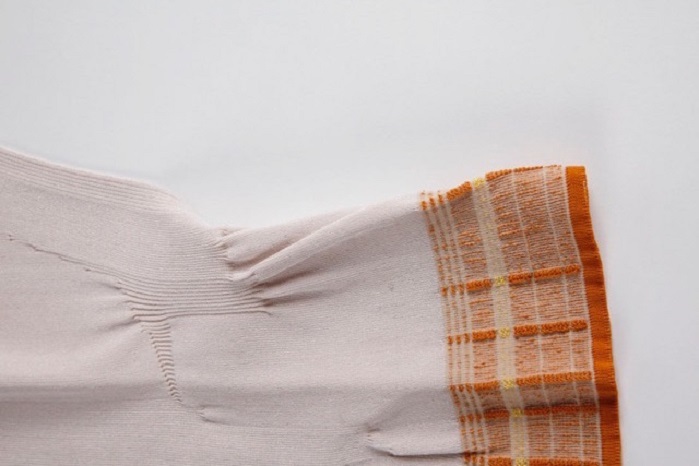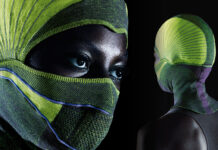
Graduating from the Royal College of Art in 2018 with an MA in Textiles, London based designer Scarlett Adams is a knitter, designer and artist. The intensive illustration process behind her graduate knitted fabric collection will be showcased at New Designers 2019. Within the One Year In room visitors will find her striking illustration collection Landscapes of the body, revealing her personal approach to designing knitted fabrics.

Having completed her BA in Fashion Textiles at London College of Fashion, followed by her MA at the RCA, Scarlett is now venturing down her own creative path, blending her knowledge of textiles with her illustrative skills. With a fluid design process, Scarlett has a unique approach to knitted textile design – one that focuses on the preservation of the analogue in a world consumed by digitalisation.
Scarlett would sooner spend 8 hours hand transferring stitches on a 14gg Flat Bed knit than focus on technological pursuits. Inspired by the forms of the human body, Scarlett moves from illustrations to knitting, and returns to paper once more, in an ever circular process where mark making informs yarn, and line informs stitch.

With a particular interest in the complexities of knitted structures, the detail captured within Scarlett’s drawings is always present in her fine tuned fabrics. Attention to detail combined with a fundamental understanding of flat bed machine capabilities allows Scarlett to craft knitwear that leads one to wonder how she could have achieved such fluidity in stitch, in a medium that is so often vulnerable to linearity.
When asked whether she would rather work digitally to design knits that require more complex needle bed set ups, Scarlett responded: “Individually transferring stitches and maintaining a tactile connection with each fabric I design is the most enjoyable part for me.”
Describing herself as a fabric maker, Scarlett’s focus is within the development of complex stich structures, pushing the boundaries of what hand and machine can achieve. It is here, Scarlett feels, that innovation can be focused upon in terms of the synergy between digital and analogue knitting methods.
How does drawing inspire you?
It was during her final year at LCF, Scarlett explained, that she found the confidence to draw and discovered her own approach to mark making. As a finalist for the LCF x Cass Art Illustration competition, Scarlett first began producing fashion illustrations of her knitted textiles collection. By experimenting with projecting her knitted forms onto the body, her fabrics became her drawings.

By attending extra drawing workshops and learning more about her capabilities, Scarlett grew in confidence and took her new found love of drawing into her MA at the RCA.
Selected as a finalist for an industry brief in collaboration with Italian Spinner Loro Piana, Scarlett’s ability to create luxury, contemporary knitted swatches was recognised. Visiting Loro Piana’s factories and learning about their manufacturing and spinning process furthered Scarlett’s interest in exploiting yarn capabilities to their fullest potential. It was then that she began to consider how a yarn can be translated into a drawn line. The significance of the relationship between the two resonated with her.
Scarlett’s interest in yarn capabilities combined with her many years of experience working with colour and form, allows her to create yarn and colour palettes that are cohesive across paper and textiles. The mood of her palette translates from the surface of matte paper to the lustre of filament yarns and slick knits. This harmony is no accident; Scarlett’s focus on the value held within her knitted pieces alongside her art works is balanced. Both are of as much value to the other.
By recording visual movements of the hinges of the body, Scarlett maps the movement of elbows, faces, knees and wrists through photography and illustrations.
In this way, Scarlett describes her process as,“creating static movement of the body, capturing the fast paced world humans live in”. She continued: “By using colour and technique with the human form I create visual data which I translate into knitted structures”.
What is the inspiration behind your work and aesthetic?
Scarlett explained: “The overarching themes of ‘Landscapes of the Body’ have been separated into movement, broken lines and moving ribs. Colours have been derived from contemporary dance and local landscapes, this involves nude tones, with highlights of orange, blue and green. This achieves an overall balance of movement”.

In relation to Landscapes of the body, Scarlett reflected: “One aspect of inspiration for me is Martha Graham, who danced and choreographed for over seventy years. She considered the weight, colour and texture of fabrics. She used dressmaking techniques that would enhance the human form without restricting it. Like Graham, I allow the technical and structural abilities of the samples to show. This is derived from using yarns that open up stitches such as silk and viscose, in contrast with stretch yarns. Communicating the themes of my research is developed through techniques such as moving ribs, which create a contoured silhouette on the body.”
What comes first: the illustration or the knitting?
Scarlett’s response to this question began with a pause. For her, it seemed that this was difficult to quantify. She then followed: “both inform each other; it is a circular process. Sometimes, I will draw and knit what I see, other times I will create a 3D knit that I re-work into a drawing and imagine in a larger scale, experimenting with colour. It evolves constantly from stitch to paper and back again.”

Scarlett went on to explain that her drawings are a response to and an initiator of her fabric creations. The human form inspires the literal outlines of her drawings in her ‘Human Head’ series, but her stitch structures inspire the movement within her more abstract pieces. Inspired by the connection that Martha Graham held between her movement and her fabric choices, so too Scarlett’s fabrics resonate with her illustrations. Her design choices hold movement, flex and fluidity at the forefront, making luxury performance knits that would be well placed within dance and sportswear contexts.
One Year In: What is on the horizon?
New Designers 2019 is somewhat of a re introduction for Scarlett into the creative industries. Recognised already for her abilities within textiles, her handwriting as an artist is little known to date. Revealing the illustrative art works that inspire, drive and challenge her knitted practice is a chance to learn more about a unique, hand crafted approach to innovative design. The scale of her pieces, some as large as A1 cannot be appreciated in digital formats, and with her love of analogue processes being so prevalent in her work, seeing the works in person is an opportunity not to be missed.

Scarlett aspires to set up a creative studio where mixed media approaches can be explored, and a sense of community through workshop teaching and technical knitting support can be given.
In an industry dictated by digital methods, it is certainly refreshing to see an up and coming designer put faith in her tactile craft ability, showing no compromise for the digital; certainly one to watch.
Tickets for New Designers can be purchased online, and Scarlett’s work will be on show in the One Year In Room during Week 1 from the 26-29 June 2019.
Scarlett will be with her work each day, available to meet and discuss her process.

Subscribe To Our Newsletter
Join our mailing list to receive the latest news and updates from our team.





